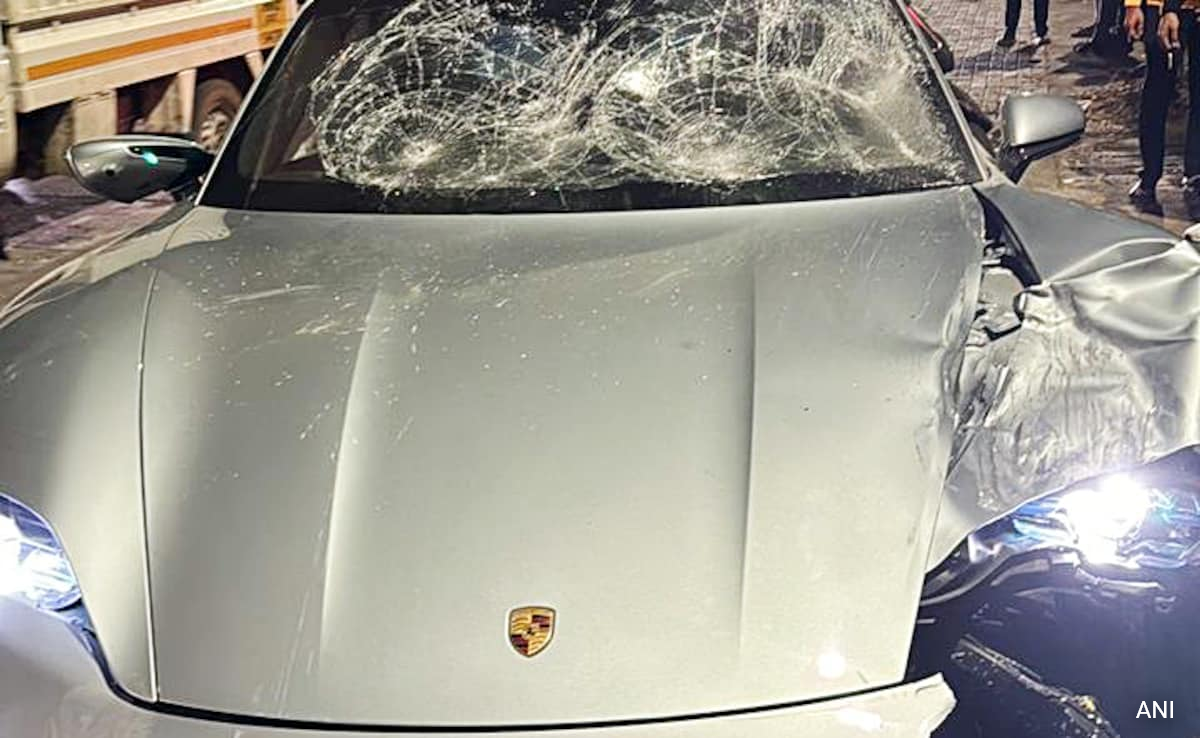Russian defense minister corruption scandal could taint others, UK says
A bribery investigation into Russian Deputy Defense Minister Timur Ivanov is likely to touch the higher echelons of Russia’s government, the U.K.’s Ministry of Defense said Wednesday.
The investigation into Ivanov, who is accused of accepting a large bribe while in office, “has likely pulled in the more senior First Deputy Defence Minister Ruslan Tsalikov,” the ministry said in an intelligence update on social media platform X.
“It has been reported that Tsalikov has been questioned by the FSB in connection with the Ivanov case. Tsalikov has been described as a patron of Ivanov. Tsalikov is likely effectively number three in the Ministry of Defence hierarchy, after Defence Minister Sergey Shoygu and Chief of the General Staff General Valery Gerasimov,” the update added.
In this pool photograph distributed by Russian state owned agency Sputnik, Russia’s President Vladimir Putin (C), Russian Defence Minister Sergei Shoigu (R) and Deputy Minister of Defense of the Russian Federation Timur Ivanov (L) visit the military Patriot Park in Kubinka, outside Moscow, on September 19, 2018. Russian law enforcement have detained Deputy Defence Minister Timur Ivanov on suspicion of taking bribes, Russia’s Investigative Committee said on April 23, 2024.
Alexey Nikolskiy | Afp | Getty Images
Ivanov denies the charges, but has already been fired by Defense Minister Sergei Shoigu, a source told Russian state news agency Tass. Two other suspects were arrested in relation to the inquiry: Alexander Fomin, the co-founder of a construction company, and Sergei Borodin, a close associate of Ivanov.
They have not commented on the matter.
There is also “a realistic possibility” that investigations into Ivanov could also affect Russian Finance Minister Anton Siluanov, the U.K.’s defense ministry said. It noted that some sources had claimed that defense ministry-linked construction agencies built a house for Siluanov.
“Corruption has long been a problem in the Russian MOD,” the U.K. said, signaling that it was also a factor in “Russia’s poor performance particularly early in the Ukraine conflict, where corruption was blamed for expired ration packs and poor-quality tyres, and fuel embezzlement was also reported.”
— Holly Ellyatt
Tear gas, water cannons, stun grenades: Police crack down on protests against controversial law in Georgia
Protestors clash with the police as they block the exists of the parliament building to prevent the ruling Georgian Dream Party’s deputies from leaving within a protest against the bill on ‘Transparency of Foreign Influence,’ in Tbilisi, Georgia on April 30, 2024. (Photo by Davit Kachkachishvili/Anadolu via Getty Images)
Davit Kachkachishvili | Anadolu | Getty Images
Police used tear gas, stun grenades and water cannons against protesters in Georgia’s capital Tbilisi on Tuesday night as demonstrations over the so-called “foreign agent” bill escalated.
The bill would force non-governmental organizations, campaign groups and media platforms who receive at least 20% of funding from abroad to register as “foreign agents.”
Police use tear gas to disperse protesters near the Georgian parliament during a rally against a controversial “foreign influence” bill, which Brussels warns would undermine Georgia’s European aspirations, in Tbilisi on April 30, 2024.
Giorgi Arjevanidze | Afp | Getty Images
Law enforcement officers detain a protester during a rally against a controversial “foreign influence” bill, which Brussels warns would undermine Georgia’s European aspirations, near the parliament in Tbilisi on April 30, 2024.
Giorgi Arjevanidze | Afp | Getty Images
The bill’s opponents say the bill would obstruct media freedom, and push the country away from the European Union and closer to Russia. The U.S. State Department has said it is “akin to the kinds of legislation that we see in the Kremlin.”
— Sophie Kiderlin
Ukraine launches drone attacks on several Russian regions, officials say
Ukraine launched drones on several Russian regions in hours leading to Wednesday morning, Russian officials said, with unofficial Russian news outlets reporting a fire at the Ryazan oil refinery after the attack.
Pavel Malkov, governor or the Ryazan region, which shares a border with the Moscow region in its northwestern parts, said that there were no injuries in the drone attacks there.
Russian Telegram channel Baza, which is close to the security services, reported that the attack sparked a fire at the Ryazan oil refinery.
A gas flame is seen behind a barbed wire in the former Yukos and current Rosneft oil company production plant in Prirazlomnoye, western Siberia.
Tatyana Makeyeva | Afp | Getty Images
The refinery, owned and run by Rosneft, refines about 5.8% of Russia’s total refined crude. It has been a frequent target for Ukraine’s air attacks.
The governors of the Kursk and Voronezh regions in southwest Russia that border Ukraine also reported drone attacks on their territories, saying there was no damage or injuries.
Russia rarely discloses information about the full impact of Ukraine’s attacks on its territory and infrastructure.
Kyiv officials say targeting Russia’s military, energy and transport infrastructure undermines Moscow’s war effort. Reuters could not independently verify the Russian reports.
— Reuters
Russia could be shifting focus onto strategic target, Chasiv Yar
Russian forces appear to be shifting their operational focus on to Chasiv Yar in the northern area of Donetsk, in eastern Ukraine.
Russia did not make any confirmed advances in the Avdiivka area for the first time in several days on Tuesday, analysts at the Institute for the Study of War noted, while Ukrainian sources reported that Russian forces conducted several more attacks in the Bakhmut-Chasiv Yar direction in recent days than around Avdiivka, in central Donetsk.
“The Ukrainian General Staff’s reports on Tuesday stated that Ukrainian forces had repelled a total of 47 Russian attacks in the Avdiivka direction and 57 Russian attacks in the Bakhmut direction throughout the day, notably a much higher number of attacks in the Chasiv Yar direction than Ukrainian sources have recently reported,” the Institute for the Study of War noted Tuesday.
“One day’s worth of reporting is not sufficient to establish a pattern, but it may suggest that Russian forces are somewhat slowing down the rate of attacks around Avdiivka while re-committing to offensive pushes around Chasiv Yar, as ISW recently forecasted they would,” ISW analysts said.
A Ukrainian serviceman drives a British FV103 Spartan armoured personnel carrier on a road that leads to the town of Chasiv Yar, in the Donetsk region, on March 30, 2024, amid the Russian invasion of Ukraine.
Roman Pilipey | Afp | Getty Images
The apparent shift in focus suggests Russians are concentrating forces in the area ahead of an attempt to seize Chasiv Yar, a town that’s seen as a key target for Russian forces because it lies on strategic higher ground and is seen as a gateway to advancing on the so-called “fortress belt” of Ukrainian-held cities in Donetsk, including Kramatorsk and Sloviansk.
“Chasiv Yar is an operationally significant objective as it would provide Russian forces with a staging ground to launch offensive operations against Druzhkivka and Kostyantynivka, which form the fortress belt of four major cities in Donetsk Oblast [region],” ISW analysts said.
— Holly Ellyatt
Russia looks to beef up weapons, forces ahead of new offensive
Russia appears to be looking to strengthen the weapons supplies and combat strength of its forces ahead of an expected new large-scale offensive in mid-May, early June.
Russian Defense Minister Sergei Shoigu commented Wednesday that to maintain the pace of current offensive operations and ahead of “further actions,” more weapons and military equipment needed to be sent to the front lines.
“To maintain the required pace of the offensive and ensure the build-up of the combat strength of troop groups for further actions, it is necessary to increase the volume and quality of weapons and military equipment supplied to the troops, primarily weapons of destruction,” Shoigu said, according to a Google translated report by RIA Novosti.
Russian President Vladimir Putin (L) talks to Defence Minister Sergey Shoigu (R) during the annual Navy Day Parade on July 30, 2023, in Saint Petersburg, Russia.
Contributor | Getty Images
Speaking at a meeting at the headquarters of the Joint Group of Forces, Shoigu also reportedly noted that troops “continue to carry out tasks in operational directions in accordance with the plan for the special military operation,” as Russia still calls its war against Ukraine.
Russia is widely expected to launch a new offensive against Ukraine in mid-May or June with the capture of Chasiv Yar, west of Bakhmut, seen as a key target in the eastern Donetsk region where fighting remains at its most intense.
Russia’s defense ministry claimed earlier this week that its forces had seized two more villages to the north and northwest of Avdiivka, building on recent advances near the industrial city that they seized in February.
— Holly Ellyatt
Estonia accuses Russia of violating international rules with GPS interference
Estonia, which shares a nearly 300-kilometer-long (182 miles) border with Russia, accused Moscow of violating international regulations by interfering with GPS signals and affecting civil aviation in the region.
Finnair on Monday said it had temporarily suspended daily flights to Tartu in eastern Estonia “so that an alternative approach solution that doesn’t require a GPS signal can be put in place at Tartu Airport.”
The Finnish airline said in a statement that two Finnair flights en route to Tartu had to be diverted back to Helsinki last week after GPS interference, which it said was “quite common” in the area.
Estonian Foreign Minister Margus Tsahkna on Monday accused Russia of GPS interference in Estonian airspace that had affected civil aviation in the region. He did not provide any evidence to support his claim.
Tsahkna added via social media platform X that he intended to address the issue with NATO allies and European Union member states.
A spokesperson for Russia’s foreign ministry was not immediately available to comment when contacted by CNBC on Tuesday.
— Sam Meredith
Russia says it shot down U.S.-supplied ATACMS missiles
Russia said it shot down six U.S.-supplied long-range missiles, known as Army Tactical Missile Systems, or ATACMS, over the past day.
In a Google-translated update on Telegram, Russia’s defense ministry said that air defense systems had, in the past 24 hours, “shot down … six ATACMS operational-tactical missiles made in the USA.” It added that Ukrainian drones and French-made “Hammer” guided bombs had also been shot down.
The ministry did not provide evidence for the claim.
The U.S. has quietly supplied the long-range missiles to Ukraine in recent weeks, enabling Kyiv to strike Russian military targets up to 300km (190 miles) away. It’s uncertain how many ATACMS missiles Ukraine was given. The missiles were used for the first time in mid-April, when a Russian airfield in Crimea was targeted. Ukraine has not commented on the latest attack.
In this handout photo released by the South Korean Defense Ministry, U.S. M270 Multiple Launch Rocket System firing an MGM-140 Army Tactical Missile during a U.S. and South Korea joint missile drill aimed to counter North Korea’s intercontinental ballistic missile test on July 5, 2017 in East Coast, South Korea.
South Korean Defense Ministry | Getty Images
Russia’s defense ministry did not say where the ATACMS missiles were shot down, but the Russian-installed head of Crimea, Sergei Aksyonov, commented in a Google-translated post on Telegram that ATACMS missiles were neutralized over the peninsula that Russia has occupied since 2014.
“After the ATACMS missiles were shot down, the undetonated submunitions scattered,” he said, warning civilians not to touch or approach any unspent submunitions.
CNBC was unable to verify the information in the posts.
— Holly Ellyatt
Odesa attack being investigated, Ukraine’s prosecutor general says
The Palace of Students of the Odesa Law Academy is on fire due to a Russian missile attack in Odesa, Ukraine, on April 29, 2024, which has killed five people
Ukrinform | Nurphoto | Getty Images
A Russian attack on Ukraine’s southern port city of Odesa is being investigated, Ukraine’s Prosecutor General Andrii Kostin said Tuesday.
Five people died in the attack on a busy seafront park, and 32 others were injured, with the majority of them still receiving treatment in hospital Tuesday.
Kostin said in a statement on X that by seemingly targeting civilians in the strike, Russia “cynically disregards all norms of international humanitarian law.”
“Yesterday evening, in the enemy’s insidious attack on Odesa, five people were killed and over 30 injured. Among the wounded are two children and a pregnant woman. Five of the hospitalized are in critical condition.”
“The strike was carried out with an Iskander ballistic missile equipped with a cluster munition. This is an indiscriminate weapon, the use of which can lead to significant civilian casualties. Metal fragments and missile debris were recovered within a 1.5 km radius from the attack site,” he said.
The investigation has grounds to believe that Russian forces officers decided to use this particular weapon “deliberately to kill as many Ukrainian civilians as possible,” Kostin said.
The investigation is ongoing, he said, pledging to hold those responsible to account. Russia denies deliberately targeting civilians.
— Holly Ellyatt
Russia likely used ballistic missile with cluster warhead in Odesa attack, official says
Russian forces used an Iskander missile armed with a cluster warhead to carry out the deadly strike on a crowded seaside area of Odesa on Monday, an official said.
Dmytro Pletenchuk, a spokesperson for Ukraine’s Southern Defense Forces, told national media late Monday that early information suggested Russia had targeted the area with an Iskander-M ballistic missile equipped with a cluster munitions warhead.
“Preliminarily, that it was an Iskander, preliminarily a cluster one. But until all relevant expert measures are taken, I will not say 100%. However, judging by the holes on the walls, it had just cluster munitions inside, such as shrapnel, and the detonation was airborne,” he said, according to the Ukrainian News Agency.
He noted that cluster bombs were primarily used to hurt civilians rather than infrastructure, noting, “as you can see, Russians see civilian residents of the city of Odesa … as a military force.”
CNBC was unable to verify the information commented on by Pletenchuk.
This photograph taken on April 29, 2024, in Odesa, shows a burning building damaged as a result of a missile attack, amid the Russian invasion of Ukraine.
Oleksandr Gimanovoleksandr Gimanov | Afp | Getty Images
Five people were killed and a further 32 injured — some seriously — in an attack on the seafront park in Odesa Monday. The attack came when many people were enjoying the park after work or walking their dogs, officials said. A local landmark, a law academy, was seen on fire with its roof missing.
Russia denies deliberately targeting civilians in the war against Ukraine. Both Russia and Ukraine have used cluster munitions in the conflict. The weapons are controversial as they’re known to pose a high threat to civilians.
— Holly Ellyatt
Five dead and many injured in Russian missile strike on Odesa
This photograph taken on April 29, 2024, in Odesa, shows a burning building damaged as a result of a missile attack, amid the Russian invasion of Ukraine. A Russian missile strike on April 29, 2024 killed at least two people and wounded eight in the south Ukrainian port city of Odesa, the local governor said.
Oleksandr Gimanov | Afp | Getty Images
A day of mourning has been declared in the Ukrainian port city of Odesa after a Russian missile strike killed five people and left 32 other injured.
The Russian strike hit a popular seafront park where many people were relaxing or walking their dogs after work, officials said. A law academy building was pictured on fire after the attack.
“The Russians hit one of the most popular locations among Odessa residents and visitors with a ballistic missile, previously with a cluster munition, where people walked with children, dogs, played sports…
Such munitions are used to kill manpower and pose a threat primarily to people, not for machinery and buildings,” Oleg Kiper, the head of the Odesa regional military administration, said on Telegram.
People look towards a burning building damaged as a result of a missile attack in Odesa, on April 29, 2024, amid the Russian invasion of Ukraine. A Russian missile strike on April 29, 2024 killed at least two people and wounded eight in the south Ukrainian port city of Odesa, the local governor said.
Oleksandr Gimanov | Afp | Getty Images
In an update Tuesday, Kiper said a number of people remain in a serious or extremely serious condition in hospital.
Gennadiy Trukhanov, Odesa’s mayor, described the attack as deplorable on Telegram: “Inhumans target peaceful people who were just resting after a day’s work. Walked with small children. With pets. There are no words that can express our attitude towards those creatures that bombard our cities. Russia is a terrorist country.”
Russia says it does not deliberately target civilians in the war against Ukraine, although thousands have died in attacks on residential and civilian infrastructure since the war started in February 2022.
— Holly Ellyatt





